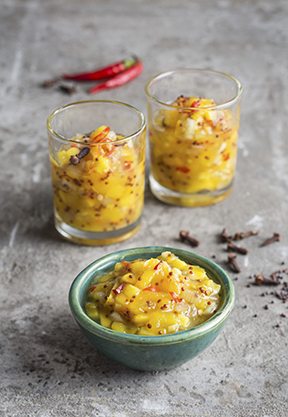Low Sodium Indian Mango Chutney
When we were courting, one of my wife’s go to dinner options was a baked chicken stuffed with chutney. It was a sweet and savory treat wrapped up in a chicken breast and pan fried or baked. I thought it was great. I had been a fan of stuffing chicken breasts for a long time. Chicken dishes are often high in sodium due to how they are processed, Especially if they are frozen. So the toppings and treatment of chicken has to change in order for chicken to stay as an option on our low sodium menu. Today we are talking about making a low sodium Indian Mango Chutney.
What is Chutney?
According to Wikipedia: Chutney is a condiment or sauce in the cuisines of the Indian subcontinent that can include such forms as tomato relish, a ground peanut garnish or a yogurt, cucumber and mint dip. An offshoot that took root in Anglo-Indian cuisine is usually a tart fruit such as sharp apples, rhubarb or damson pickle made milder by an equal weight of sugar (usually demerara or brown sugar to replace jaggery in some Indian sweet chutneys).
Originally from India, Chutneys spread to Great Britain and all of the British Colonies during the British occupation of India. In Britain, Chutneys are typically eaten with a Cheddar-type cheese or with cold meats and fowl, typically in cold pub lunches.
American and European-style chutneys are usually fruit, vinegar, and sugar cooked down to a reduction, with added flavorings. These may include sugar, salt, garlic, tamarind, onion or ginger. Western-style chutneys originated from Anglo-Indians at the time of the British Raj recreated Indian chutneys using English orchard fruits—sour cooking apples and rhubarb, for example. They would often contain dried fruit: raisins, currants and sultanas.
How Do You Use Chutney?
Chutneys can be used as something simple as a spread for bread or crackers. You can add it to a Charcuterie board to pair with meats, nuts, and cheeses. Or as my wife likes to do is to use it as a flavoring for meat, fish, or poultry. She loves to take fresh chicken breasts and butterfly cut them open. She will pound them flat, then spread chutney on them and add some Swiss cheese and roll them up. She will tie them with some bakers string and season the outside of the chicken breast and then roast them stove-top or in the oven.
From The Cookbook
This recipe is in my new cookbook – The Easy Low Sodium Diet Plan & Cookbook. It is available on Amazon or in Barnes and Nobles Stores. You can also ask at your local book store for them to order it. The pictures of this dish are from the amazing Shea Evans, an exceptional food photographer. Check out some of his work at Sheaeveans.com.
Here Is The Recipe For Low Sodium Indian Mango Chutney

Low Sodium Indian Mango Chutney
Ingredients
- 1 tbsp Peanut oil
- 1/2 tsp Panch Phoran An Indian spice blend, or you can use equal parts mixed of ground cumin, ground fennel, ground mustard, and fenugreek
- 2 medium Semi-ripe Mangoes Peeled, seeded, and finely chopped
- 1 tbsp Fresh Ginger Grated
- 1/4 tsp Red Chili Powder
- 2 tbsp Jaggery or White Sugar
- 1/8 tsp Garam Masala
- 1/2 tsp Ground Cloves
Instructions
- In a medium skillet, heat the oil over medium high heat. Add the panch phoran (or spice mix) and fry gently while stirring until fragrant - 1 to 2 minutes
- Add the ginger and cook for another minute.
- Add the mango, red chili powder, garam masala, and he cloves. Stir and simmer for 1 to 2 minutes.
- Next add the jaggery or sugar and stir to cook 2-3 more minutes. Don't overcook, as the mixture will become thick.
- Transfer the mango chutney to a serving bowl and serve warm or room temperature as a dip or spread.
